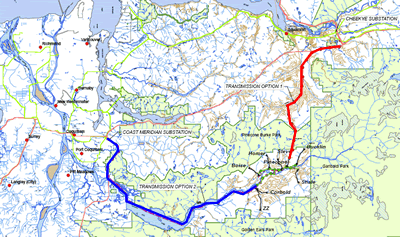

Green power? Don't let a name fool you
COMMENT: The government created this situation by accepting the water licence applications in an area surrounded by parks. It's the government's duty to fix the problem - without slicing strips out of parks to accommodate transmission lines.
If they start "realigning" park boundaries for this generation project, there will be no end to it as more and more small hydro, wind and distributed power projects roll out across the province under the government's "self-sufficiency by 2016" goal.
Even if the company is correct, that going through the park will be cheaper and will likely have fewer impacts on the environment and communities, that's not the issue.
Land in a park is protected, as the Park Act defined it years ago. It is not a place to "park" land until somebody wants to use it for something else.
MARK HUME
Globe and Mail
09-Apr-2007
VANCOUVER -- Gwen Barlee and Joe Foy are veteran B.C. environmental campaigners who, over the years with the Western Canada Wilderness Committee, have engaged in battles to save forests, protect rivers and save endangered species from extinction.
They are far from naive. But this weekend, as they sat down to discuss strategy about the looming threat posed by hundreds of independent power projects in B.C, the first thing they had to admit was that they felt duped.
They, like many other British Columbians, are worried about global warming and so when the government started talking about the need for more "green power" to save the world, they bought into the idea of micro-hydro projects.
The idea sounds simple. Find a fast-flowing stream that has a waterfall or other natural barrier to fish migration. Build a small dam above that point, divert the water into a penstock, power a turbine, and return the water to the river so the fish downstream can use it.
But last week Ms. Barlee had a look at a "green power" project being built on the Ashlu River, near Squamish. She was shocked.
Huge swaths were being cut through the forest to facilitate power lines. The power plant itself was a major construction site. Blocking a public road was a gate staffed by workers who demanded to see her identification and told her taking pictures was forbidden.
"Here I thought they were building a nice, little, green-power plant," she says. "It turns out it is a major development, with major environmental impact."
She notes there are 498 licences for micro-hydro projects in B.C. -- and people had better wake up to what it really means.
"What we are talking about here are public rivers going into private hands . . . This was my first look at what one of these things actually entails, and I was blown away. Appalled. I was incredibly naive to accept these projects as green."
Mr. Foy agrees. "We have been going to meetings concerning the plan to put eight of these dams on tributaries of the Pitt River," he says. "But there is no public oversight.
"Instead of dealing with government officials, we find ourselves in a room with stock promoters who are in this for profit. If you were dealing with the government you could say, 'We should look at this in terms of the public interest.' But the private developers can't do that. They are looking only at what's good for them. They see nothing wrong with damming salmon rivers or putting power lines through public parks. When we question that they say, 'So what's wrong with that? This is green power.' "
The proposal on the Pitt, by Northwest Cascade Power Ltd., would dam eight important tributaries that flow into the main river, which joins the Fraser River, near Vancouver. One of two proposed power line routes would cut through a provincial park.
Danny Gerak, owner of Pitt River Lodge, a fishing resort, says that when he first heard about the proposal he, too, bought into the green-power dream. Only in the past week, after having met with company officials and touring some of the proposed dam sites, has he changed his mind.
"I am dead set against this project," he says. "It is massive in scope. The dams they propose will cut off fish from moving upstream, contrary to what they say, and they are going to divert the water away from . . . important fish habitat.
"The combined impact of these dams, together with the roads and power line right-of-way, will change this valley forever. It will be devastating."
Mr. Foy, his naiveté shattered, says the Ashlu was lost without much of a fight. But his organization is gearing up for a battle over the Pitt.
"I have told the developers, 'You are in for a war. You just can't do this.' . . . There are clearly places where these kind of projects should never be built, and the Pitt River is one of them."
Some of the larger micro projects in B.C. will undergo environmental reviews, but those generating less than 50 megawatts will not. The cumulative impact of the projects is unknown, but stream by stream it will add up to major environmental degradation.
Green power? Hardly. The ancient Chinese had a better term for it. Death by a thousand cuts.
Related materials

Upper Pitt River Power Project map.
Click here for larger version.
Say NO to transmission lines in BC's parks
Upper Pitt River Power Project at the Environmental Assessment Office
www.eao.gov.bc.ca/epic/output/html/deploy/epic_project_home_291.html